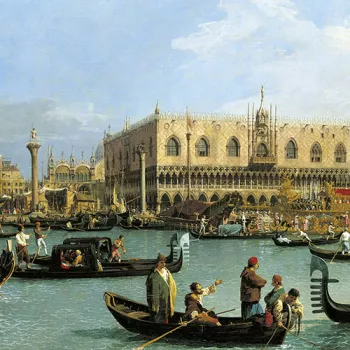Capriccio View of the Courtyard of the Palazzo Ducale with the Scala dei Giganti Signed and dated 1744
Oil on canvas | 108.2 x 129.9 cm (support, canvas/panel/stretcher external) | RCIN 406012

Canaletto (Venice 1697-Venice 1768)
Capriccio View of the Courtyard of the Palazzo Ducale with the Scala dei Giganti Signed and dated 1744
-
The viewer has entered the Palazzo Ducale (Doge's Palace) through the Porta della Carta and the Arco Foscari, and ahead is the great staircase built by Antonio Rizzo in 1497. A daring design with a half-landing flanked by elegant balustrades, the façade is richly decorated with carved ornament and figures, niello patterns and stones of different colours. The three round arches of the first-floor arcade at the top of the staircase, resembling a Roman triumphal arch, lead to the palace entrance. Towering over visitors at the top of the staircase are Jacopo Sansovino's impressive figures of Mars, which originally held a sword, and Neptune, which held a trident. These were installed on the staircase by 1567 as symbols of the Venetian Republic's military domination of land and naval power over the sea. At around 4.4 metres high, they are famous examples of the Renaissance taste for colossal sculpture.
The gallery was the setting for the climax of every ducal coronation, depicted by Canaletto in his drawing of the coronation of Doge Alvise IV Mocenigo, and the place where the Doge would welcome ambassadors and important visitors. Below the stairs was a small prison used to house traitors and enemies of the state. In reality the view approaching the Scala dei Giganti through the Arco Foscari is framed by an arch. A few years earlier Canaletto had accurately depicted the view for Sir Hugh Smithson, later Duke of Northumberland (The Courtyard of the Doges' Palace with the Scala dei Giganti, Alnwick Castle, Northumberland); at the same time as he was painting Smith's capriccio he also made a small replica of the Northumberland painting for George Garnier (private collection).
The capriccio repeats the direction of light and many of the figures in the Northumberland painting. Here, however, he has moved the viewpoint slightly to the right and introduced the framing device of the double arch to heighten the theatrical effect. He would go on to develop the arch or double arcade as a favourite framing device seen, for example, in his views of London observed through an arch of Westminster Bridge.
Lively figures populate the scene: on the steps a Procurator or Senator is being greeted, while at the bottom a pair of bewigged officials in black discuss business. A man on the left points out to his daughter the wonders of the staircase. By the double columns in the foreground a man, also in the Northumberland painting, looks out at us. Above the arches on either side of the staircase are shields held by flying Victories. That on the right has a chevron, the coat of arms of the Canal family. Canaletto rarely combined his coat of arms with his signature in a single work, suggesting that he was particularly pleased with this painting.
This painting is one of a series of thirteen overdoors by Canaletto, all with the same provenance. Of the thirteen pictures, nine survive in the Royal Collection.
Signed and dated on the base of the pair of foreground pillars: ANTO. C. F. / MDCCXLIV.
Text adapted from Canaletto & the Art of Venice, 2017.Provenance
Acquired by George III from the collection of Consul Smith in 1762 (Italian List no 88); recorded in the Old Dining Room at Buckingham Palace in 1819 (no 825)
-
Medium and techniques
Oil on canvas
Measurements
108.2 x 129.9 cm (support, canvas/panel/stretcher external)
133.8 x 152.7 x 14.0 cm (frame, external)
Category
Object type(s)
Other number(s)
Alternative title(s)
Venice: Caprice View of the Courtyard of the Doges' Palace with the Scala dei Giganti








